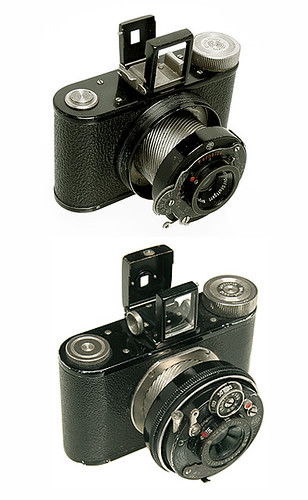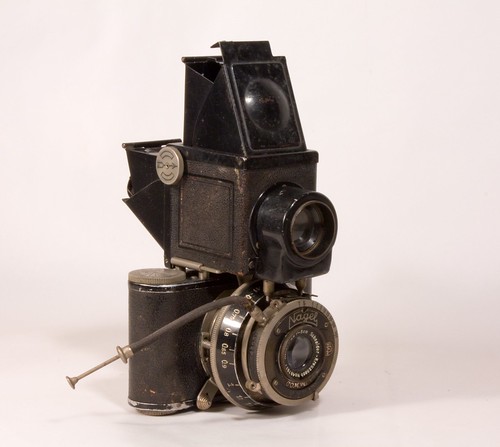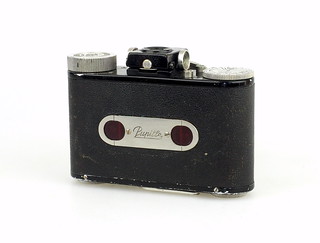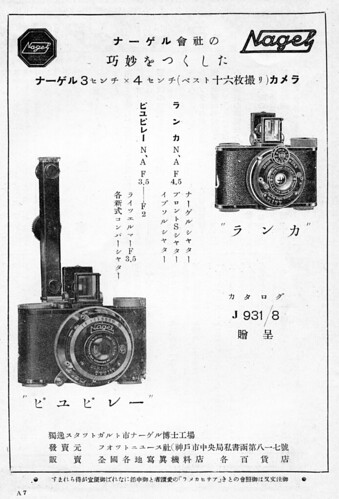Pupille
| |||||
| German, French & Italian Cameras using 127 film | |||||
| G e r m a n y |
3×4 | rigid | Dreivier | Futuro | Gewirette | Kolibri Parvola | Pupille | Ranca | Reporter | Puck | ||
| folding | Baby Ikonta | Baldi | Dolly | Goldi Gucki | Ingo | Korelle | Makinette Metharette | Perkeo | Vollenda | ||||
| 4x4 | Navax | Paxina Electromatic | Rothlar | ||||
| 4x6.5 | Bella | Billy | Bob | Dolly | Goldi Gucki | Korelle | Panta | Parvola Piccolette | Rio | Ultrix | ||||
| TLR | see German TLRs | ||||
| F r a n c e |
3×4 | rigid | Fotobaby | Lynx | Super-Boy | ||
| folding | Derby-Lux | Elax | ||||
| pseudo TLR | Auteuil | Longchamp | ||||
| 4×4 | rigid | Impera | Marly | Pari-Fex | Rubi-Fex | Top | |||
| 4×6.5 | rigid | Photo-Magic | |||
| I t a l y |
3x4 | Comet | Comet III | Cometa | Euralux Ibis | Maxima | Piccolo | Tanit | |||
| 4x4 | Comet | Euralux | Ibis | ||||
| 4x6.5 & other | Alfa | Delta | Relex | Rolet | Rondine | ||||
The Pupille is a rigid-bodied 3×4cm camera, made in the early 1930s by Nagel and later Kodak AG. It makes 16 exposures on 127 film, has a big helical mount holding the lens and shutter assembly, and a folding optical finder. With a size of only ca. 97 x 68 x 49 mm it is one of the most compact cameras of its class. It has been describe as the "Queen of the 3x4 cameras, elaborately and imaginatively designed, precisely manufactured"[1]. Almost the entire class of 3x4 cameras (see list in below table) made a short appearance on the market from about 1930 to 1934[2]. Especially the Nagel cameras paved the way for the Kodak Retina I, a camera which introduced the standard 135 cartridge and created its own class of view- and rangefinder cameras, we got so used to.
Contents
Camera specifications
- Size and weight: ca. 97 x 68 x (49, 60, 65) mm (collapsed, infinity, 70cm focus), 397g (Leitz Elmar)
- Shutter: Fr. Deckel Compur, T-B-1-2-5-10-25-50-100-300
- The available lens options include:
Special accessories
The Pupille has two small holes on the top plate, used to attach an external rangefinder made by Leitz, similar to that of the Leica Standard. Accessory reflex finders were also made, transforming the camera into some sort of TLR. At least two types were available; one is the Megoflex by Hugo Meyer, also made for other cameras; the other is pictured below and was made by an unknown manufacturer, perhaps Nagel.
|
| ||||
| Nagel Pupille with special accessories images by willboy2010 (Image rights) | |||||
Other versions and names for the camera
The Pupille was sold in England by R. F. Hunter as the Rolloroy.[6]
The Ranca is a less expensive version of the Pupille, with a front-cell focusing 5 cm f/4.5 Nagel Anastigmat and an everset shutter.[7]

|
| Nagel Ranca: two examples with 5 cm f/4.5 Nagel Anastigmat and three-speed everset shutters image by Rick Soloway (Image rights) |
Notes
- ↑ Volkmar Kleinfeld, in PhotoDeal 108 (1/2020), page 6
- ↑ Christoph Batz-Sohn, in PhotoDeal 110 (3/2020), page 4. See also Das plötzliche Verschwinden der 3x4 Kameras (in German)
- ↑ Two examples of the Nagel-branded Pupille with 5 cm f/3.5 Elmar lens sold at the tenth Westlicht Photographica auction, in November 2006: with focus scale in metres, and with both focus scale and accessory rangefinder scaled in feet, with leather case and filters.
- ↑ Kodak-branded Pupille with 5 cm f/3.5 Elmar (scaled in feet), sold at the nineteenth Westlicht auction, in May 2011; several pictures.
- ↑ Pupille with Xenon lens sold at LP Foto auction 35 on 28 March 2010 in Stockholm.
- ↑ Rolloroy with 4.5 cm f/2 Xenon lens (scaled in feet), also sold at the nineteenth Westlicht auction.
- ↑ Auction lot of three Ranca cameras sold at the tenth Westlicht auction.
Links
- Ranca at Sylvain Halgand's Collection d'Appareils (in French)
- Nagel Pupille at KniPPsen (in German)
- Kleinfilm-Pupille instructions (German only) at www.OrphanCameras.com
Image gallery
|
|
| ||||||
| Nagel Pupille details and accessories images by Christoph Batz (Image rights) | ||||||||
|
|







